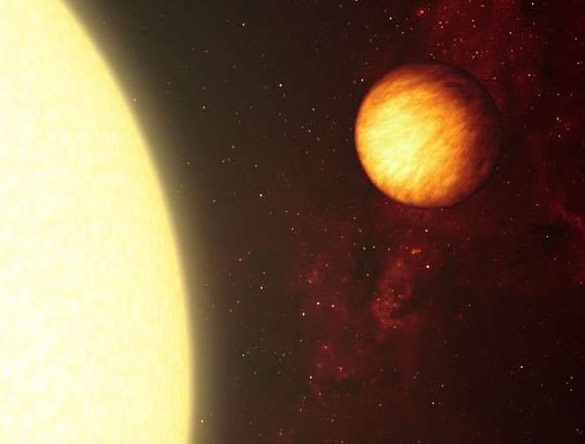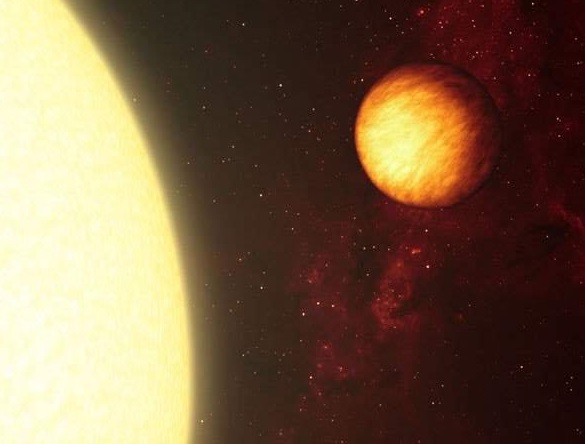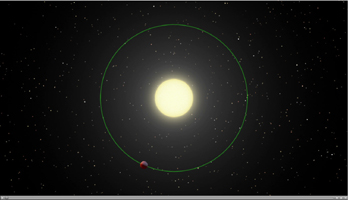

Among the billions of stars lurking within the confines of our galaxy, there are many foreign worlds that defy imagination, as many are prone to unimaginably alien characteristics… Upsilon Andromeda b is one of these worlds.
This ‘hot Jupiter’ exoplanet orbits a star, known as Upsilon Andromeda B, that lies some forty light-years from our solar system, in the way of the constellation of Andromeda. Since the planet is a ‘gas giant’, there is no solid surface that any of us could stand on. Even if there was a solid surface, this planet is NOT somewhere you would want to live, as there are two radically different environments seen on this planet. Neither are desirable.
According to Brad Hansen, who hails from the University of California in Los Angeles (USA), “If you were moving across the planet from the night side to the day side, the temperature jump would be equivalent to leaping into a volcano.”
How could this be? Well, the answer is quite simple. The planet is most likely tidally locked to its parent star (one side facing the star, with the other side facing the opposite direction). In addition, the planet orbits its star from a distance that makes the orbit of Mercury look like paradise. In fact, the planet makes one full orbit around its star in a time-span of a mere 4.6 days, whereas Mercury takes 88 days to orbit the sun.

According to the original data taken of this exoplanet in infrared by the Spitzer Space Telescope, the temperatures on the sunlit side of the planet range from 2,500 to 3,000 degrees Fahrenheit (or about 1,400 to 1,650 degrees Celsius), while the night-facing side of the planet has temperatures that delve right into the negative Celsius temperatures. (More specifically, the temperatures there were thought to range from 4 to 450 degrees Fahrenheit or -20 to 230 degrees Celsius). According to researchers, this was the very first instance of such a huge temperature variation being discovered outside of our solar system.
Such a find was quite shocking, as it is generally expected that the atmosphere of a planet should redistribute the heat it receives from its star, which is only slightly brighter and more massive than the sun. In contrast, the largest planet of our solar system tends to maintain an even temperature throughout.
Further observations of the planet a few years later uncovered something else that was entirely unexpected. The warmest portion of the planet is, in fact, not on the starlit portion of the planet that is receiving the most radiation from the star, but about 80 degrees opposite of the face of the planet, which is pointed toward the star. According to Hansen, who took part in BOTH studies,
“There are several exoplanets observed with warm spots, including some whose spots are shifted relative to the location facing the star (an example is the very well studied system HD189733b). The principal difference in this case is that the shift we observe is the largest known.”

Hansen went on to explain that they are unsure of how large the warm spot actually is, but, “At the sub-stellar point (the one closest to the star) the amount of radiation being absorbed from the star is highest, so the gas there is heated more. It will therefore have a tendency to flow away from the hot region towards cold regions. This, combined with rotation will give a “trade wind”-like structure to the gas flow on the planet… The big uncertainty is how that energy is eventually dissipated. The fact that we observe a hot spot at roughly 90 degrees suggests that this occurs somewhere near the “terminator” (the day/night edge). Somehow, the winds are flowing around from the sub-stellar point and then dissipating as they approach the night side. We speculate that this may be from the formation of some kind of shock front.”
More fascinating discoveries were still yet to come, as it is now known that there are four planets orbiting the star, which also has a partner — a red-dwarf star dubbed ‘Upsilon Andromedae B’. The other three planets in the binary system are thought to hold many more characteristics with Jupiter than the innermost planet does, making this system quite popular amidst planet hunters. Who knows, perhaps these planets are also home to a series of bizarrely Earth-like moons that we may someday explore?